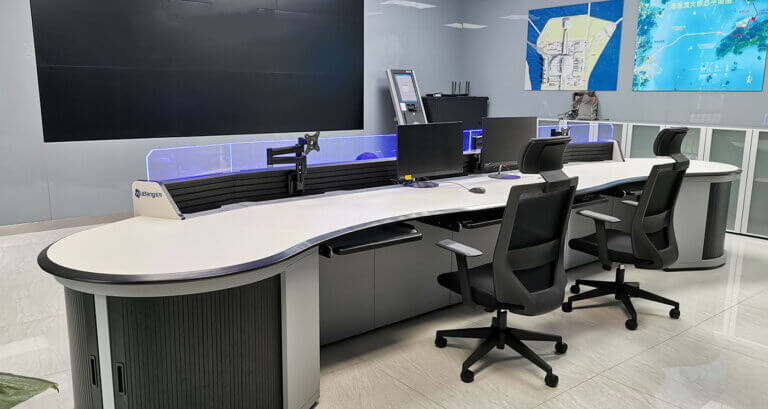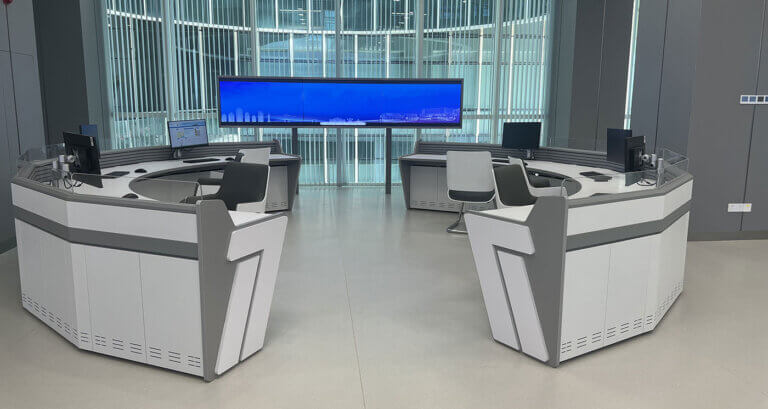
Product Categories

Hong Kong-Zhuhai-Macao Bridge Police Station

World Meteorological Center Hong Kong-Zhuhai-Macao Branch Center

Shanghai Hongqiao Airport Command Center
An airport control tower is an essential air traffic control facility responsible for the safe, orderly, and efficient flow of aircraft traffic at airports. Located in a tall structure with an unobstructed view of airport operations, the control tower houses air traffic controllers who coordinate the movement of aircraft and service vehicles on the ground and in the air.
The main functions of an airport control tower include:
Ground controllers provide taxi instructions, give information about ramp activities, and ensure the safe movement of aircraft from gates to runways. They maintain awareness of the location of all aircraft and vehicles on taxiways, aprons, and gates.
Control towers authorize aircraft to take off or land using voice communications. Tower controllers time operations appropriately considering factors like wake turbulence separation standards, runway occupancy, weather conditions, etc.
Tower controllers transfer communication with aircraft landing and taking off to/from approach/departure control facilities. This coordinated “handoff” ensures continuous controlled coverage.
Maintaining safe separation standards between aircraft both on the ground and in the air is a tower controller’s highest priority. Proper spacing eliminates collision risks and allows the maximum flow of traffic.
Towers relay changing local weather like wind or visibility to arriving and departing aircraft. They suspend operations on compromised surfaces like icy runways. Controllers also keep pilots updated regarding bird activity, debris, temporarily closed taxiways, and other issues affecting airport condition.
Professionally trained air traffic controllers staff airport towers, working from a cab or bridge overlooking the airport. Their jobs are highly demanding, requiring multi-tasking abilities and constant situational awareness. Controllers manage traffic safely while considering numerous complex factors in a dynamic environment.
There are several specialist tower controller positions:
While not all towers have radar systems, where utilized, radar enhances traffic awareness and safety. Radar allows controllers to track aircraft locations more precisely than just visually or via radio reports. Approach control radar feeds often cover tower airspace as well.
Surface movement radar specifically monitors ground operations. These systems detect potential runway incursions when vehicles or aircraft enter areas improperly. Many larger commercial airports have implemented ground surveillance radar.
Tower controllers use radio, intercom connections, and backup telephone links to control traffic with flexibility and redundancy. Radio allows direct communication with aircraft and control facilities. Phone lines connect towers internally and with airline operations centers, facility maintenance crews, crash fire rescue bases, etc.
Towers use powerful precision optics like binoculars for enhanced visibility. At night or in poor conditions, specialized infrared and heat-registering cameras allow controllers to track aircraft they couldn’t necessarily see themselves.
During instrument approaches or periods of low ceilings and visibility, controllers can access pilots’ cockpit weather radar screens via datalink. This helps determine when conditions might allow reduced spacing for landing aircraft.
An airport’s control tower dictates rules for operating within associated controlled airspace to provide order and prevent collisions. The tower controllers have responsibility for these operations.
There are several important tower environment procedures pilots must follow:
Aircraft must establish radio communication with tower controllers before entering controlled airspace or when taking off and landing. The tower frequency is either printed clearly on sectional charts in the airport’s communication box or available via automated terminal information service (ATIS).
Pilots have to request and receive explicit tower controller clearance for everything from simply entering control zones and crossing runways right up to final takeoff rolls or landing approaches. Controllers consider traffic, spacing, and priority in sequencing departure and arrival clearances.
Tower controllers issue pilots instructions like assigned headings, altitudes, speed control, etc. to maintain order and separation between aircraft. Pilot compliance creates an efficiently orchestrated flow benefiting all operators.
When not in radar contact, tower controllers depend on pilots confirming their precise positions at compulsory reporting points. Accurate position reports allow coordinating safe, economical spacing at faster speeds than non-radar handling allows.
The environment within an airport tower’s airspace is characterized by flexibility and redundancy. While structured procedures govern traffic flows, coordination between controllers and pilots enables dynamic, situation-specific control adapting safely to changing circumstances.
In the interest of safety and efficiency, aviation regulatory agencies control aircraft activity only at busier airports meeting traffic volume thresholds. There are several classes of controlled facilities with towers:
Major airline hubs with extensive passenger and cargo operations like Chicago O’Hare or New York JFK have the largest, most sophisticated tower setups. Multiple control positions coordinate round-the-clock operations. Complex integration of arrival, departure, and ground control positions enables the safe handling of heavy traffic.
Enhanced equipment like surface movement radar allows precise monitoring in low visibility. Some mega-airport towers also have contingency facilities as operational backups.
Many midsize airports serving domestic traffic flows fall into this category, like Kansas City or San Antonio. While not 24-hour, regional transport hub towers must handle busy travel periods, including simultaneous arrivals and departures.
Controllers juggle priorities between commercial carrier jets, commuter props, business jets, and private pistons. Radar capabilities vary but range from surface movement only to full radar room integration.
Many smaller yet still busy general aviation fields have local control towers operated by contractors the FAA oversees. Local towers handle sporadic airline services but mainly assist recreational, instructional, emergency, and corporate flying.
Staffing is minimal and focused around peak traffic times. Enhanced visibility tools support visual flight rules operations. Radar is not commonly present at local tower airports.
Many airports receive flight service station-based traffic advisories. Air traffic controllers don’t directly control operations, but a remotely operated aerodrome traffic frequency (ATF) allows transmitting localized safety alerts.
Pilots coordinate takeoffs and landings themselves while receiving advisory traffic callouts. Actual tower control begins once traffic levels consistently exceed thresholds sustainable long-term via advisories.
The coordinated interaction between pilots and air traffic controllers makes safe, efficient airport tower operations possible. As aviation activity continues growing worldwide, more and more airports will require control towers to handle increased traffic levels.